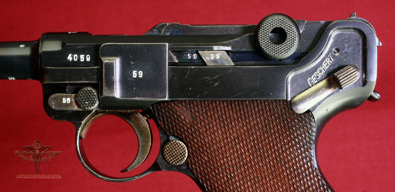
With the adoption came large orders which could not be filled in the time allotted by DWM. Buttstock and toggle-knob were completely done away with and all screws, with the exception of the ones holding the wooden grips to the frame, were replaced by pins. The lanyard ring was moved from the left side of the receiver to the rear, just above the grip safety, a new feature. The position of the ejector was changed from beneath the breechblock to the right side of the receiver, while the extractor remained unchanged. The trigger and trigger cover were altered, the latter now completely concealing the rollerpin of the sear and partially covering the sear itself. The grip was inclined at an angle to the receiver and the recoil spring was incorporated in the grip, thereby doing away with two major problems, the angle of the grip and the bulky, protruding, recoil spring housing. The barrel, though shortened, maintained its long, slim appearance. The strong and sturdy action of the Borchardt was retained along with many other of the original features, some being altered slightly and others quite radically. The inventor believed his gun to be perfect, though, and so steadfast were his refusals to redesign even the smallest component that DWM, the manufacturers, called upon Herr Luger to make the desired changes.


Excellent though it was, especially in relations to the other pistols of its day, the Borchardt left a great deal to be desired.


 0 kommentar(er)
0 kommentar(er)
